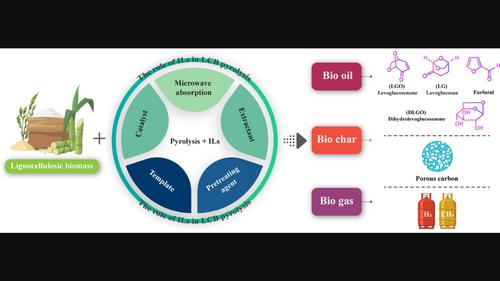A comprehensive review on how ionic liquids enhance the pyrolysis of cellulose, lignin, and lignocellulose toward a circular economy
IF 5.4
3区 工程技术
Q2 ENERGY & FUELS
引用次数: 2
Abstract
The sustainable use of plant biomass (PB) to produce new valuable compounds helps alleviate the world's excessive reliance on fossil fuels. Among the different processes available, pyrolysis has drawn significant attention for its efficiency in converting PB (including lignin, hemicellulose, and cellulose) into solid, liquid, and gas products by thermal degradation. Moreover, the participation of ionic liquids (ILs) in the pyrolysis process can further facilitate this process, improve the quality of pyrolysis products, and enhance the operational parameters. This review article presents an in‐depth examination of how ILs enhance the pyrolysis of lignin, cellulose, and lignocellulose toward sustainability and circular economy (CE). The structural chemistry of the components of PB, namely cellulose, lignin, and hemicellulose, is first discussed. Furthermore, the role of ILs in the pyrolysis of cellulose, lignin, and lignocellulose is thoroughly investigated. These roles include pre‐treating agent before pyrolysis, catalyst after or during pyrolysis, template during pyrolysis, and extractant after pyrolysis. In the following, the sustainability of PB pyrolysis with the participation of ILs is examined from three aspects: environmental, social, and economical. Finally, the PB pyrolysis was investigated from the CE aspect. There is no doubt that the participation of ILs in the pyrolysis process positively affects the operating conditions and product quality, so the whole process is only one step away from complete sustainability.

离子液体如何促进纤维素、木质素和木质纤维素的热解以实现循环经济的综合综述
可持续利用植物生物质生产新的有价值的化合物有助于缓解世界对化石燃料的过度依赖。在现有的不同工艺中,热解因其通过热降解将PB(包括木质素、半纤维素和纤维素)转化为固体、液体和气体产品的效率而备受关注。此外,离子液体(ILs)参与热解过程可以进一步促进这一过程,提高热解产物的质量,并提高操作参数。这篇综述文章深入研究了离子液体如何促进木质素、纤维素和木质纤维素的热解,以实现可持续性和循环经济(CE)。首先讨论了PB中纤维素、木质素和半纤维素的结构化学。此外,还深入研究了离子液体在纤维素、木质素和木质纤维素热解中的作用。这些作用包括热解前的预处理剂、热解后或热解期间的催化剂、热解期间的模板和热解后的萃取剂。在下文中,从环境、社会和经济三个方面考察了有离子液体参与的PB热解的可持续性。最后,从CE的角度对PB的热解进行了研究。毫无疑问,离子液体参与热解过程对操作条件和产品质量产生了积极影响,因此整个过程距离完全可持续性只有一步之遥。
本文章由计算机程序翻译,如有差异,请以英文原文为准。
求助全文
约1分钟内获得全文
求助全文
来源期刊

Wiley Interdisciplinary Reviews-Energy and Environment
ENERGY & FUELS-
CiteScore
11.70
自引率
3.30%
发文量
42
期刊介绍:
Wiley Interdisciplinary Reviews: Energy and Environmentis a new type of review journal covering all aspects of energy technology, security and environmental impact.
Energy is one of the most critical resources for the welfare and prosperity of society. It also causes adverse environmental and societal effects, notably climate change which is the severest global problem in the modern age. Finding satisfactory solutions to the challenges ahead will need a linking of energy technology innovations, security, energy poverty, and environmental and climate impacts. The broad scope of energy issues demands collaboration between different disciplines of science and technology, and strong interaction between engineering, physical and life scientists, economists, sociologists and policy-makers.
 求助内容:
求助内容: 应助结果提醒方式:
应助结果提醒方式:


